Papers by Anders Thygesen
The potential of biocomposites in engineering applications is demonstrated by using aligned flax ... more The potential of biocomposites in engineering applications is demonstrated by using aligned flax fibre/polylactate composites as a materials model system. The strength of flax fibres is measured by tensile testing of single fibres, and tensile testing of bundles of fibres. For both testing approaches, it is found that tensile strength is increased by decreasing the tested fibre volume. For single fibres, strength is increased by decreased gauge length (at constant fibre diameter). At a gauge length of 10 mm, the mean strength is 720 MPa. For bundles of fibres, strength is increased by decreasing bundle cross-section (at constant gauge length) (Fig. 1). At a fibre bundle cross-section of about 0.2 mm2, the strength is about 280 MPa. The results are analysed by Weibull theory to evaluate the "effective reinforcement volume" of the flax fibres in composites.
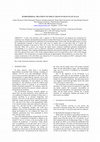
A pilot scale autoclave with a capacity of 100 kg biomass/h was designed and constructed for cont... more A pilot scale autoclave with a capacity of 100 kg biomass/h was designed and constructed for continuous wet oxidation and hydrothermal treatment of plant fiber biomass for production of sugars for bio ethanol and an alkali free solid material for combustion in an incineration plant. In this study, the pilot plant reactor was used for hydrothermal treatment of wheat straw with water in counter flow at water-straw ratio of 5 kg/kg. By hydrothermal treatment of the straw at 190°C for 15 min, 18% of the hemicellulose and 5% of the cellulose were extracted. When 200 g straw/L was treated, the liquid extract contained solubilised polymeric hemicellulose corresponding to 9 g xylose/L and 4 g glucose/L (measured as monosaccharides after dilute acid hydrolysis or enzymatic treatment). After combined hydrothermal treatment and enzymatic hydrolysis the maximum sugar, yields were 30 g glucose/100 g straw (~83% of the original cellulose) and 16 g xylose/100 g straw (~58% of the original hemicell...
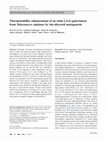
Applied Microbiology and Biotechnology, 2014
Enzymatic conversion of pectinaceous biomasses such as potato and sugar beet pulp at high tempera... more Enzymatic conversion of pectinaceous biomasses such as potato and sugar beet pulp at high temperatures is advantageous as it gives rise to lower substrate viscosity, easier mixing, and increased substrate solubility and lowers the risk of contamination. Such high-temperature processing requires development of thermostable enzymes. Talaromyces stipitatus was found to secrete endo-1,4-β-galactanase when grown on sugar beet pectin as sole carbon source. The mature protein contained 353 AA and the MW was estimated to 36.5 kDa. It was subjected to codon optimization and produced in Pichia pastoris in 2 l scale yielding 5.3 g. The optimal reaction condition for the endo-1,4-β-galactanase was determined to be 46°C at pH 4.5 at which the specific activity was estimated to be 6.93 μmol/min/mg enzyme with half-lives of 13 and 2 min at 55 and 60°C, respectively. For enhancement of the half-life of TSGAL, nine single amino acid residues were selected for site-directed mutagenesis on the basis of semi-rational design. Of these nine mutants, G305A showed half-lives of 114 min at 55°C and 15 min at 60°C, respectively. This is 8.6-fold higher than that of the TSGAL at 55°C, whereas the other mutants displayed moderate positive to negative changes in their half-lives.
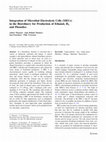
Waste and Biomass Valorization, 2010
In a biorefinery, biomass is converted into a variety of chemicals, materials and energy. A typic... more In a biorefinery, biomass is converted into a variety of chemicals, materials and energy. A typical example is the lignocellulosic ethanol biorefinery process, in which substrates such as wheat straw are used as a feedstock for production of ethanol. In this work, an integrated biorefinery procedure is proposed in which the ethanol biorefinery is coupled with a microbial electrolysis cell (MEC), with the aim to further process and valorize the waste stream of bioethanol production. A MEC is an electrochemical system capable of oxidizing reducing equivalents, which results in hydrogen production. The mass and energy balances as well as the economical evaluations, show that this strategy may be useful for additional generation of hydrogen and lignin, thereby increasing the final yield of this biorefinery. From one ton of straw, the yield of ethanol upon yeast fermentation is estimated at 177-190 kg, with a hydrogen yield corresponding to 19-23 kg H 2 . The remaining solid residue of 147-160 kg comprises primarily lignin. The estimated value of these products approximates the double of that of straw. Integrating a MEC in the biorefinery concept may also be useful for other applications such as polyphenol purification and targeted modification of fruit based phenolics. Examples of such high-value plant polyphenols include equol and resveratrol, which can be produced from soy and grape, respectively.
Journal of Natural Fibers, 2006
... of these composites (Thygesen et al., unpublished; Table 2). The same proper-ties of composit... more ... of these composites (Thygesen et al., unpublished; Table 2). The same proper-ties of composites with fibers from untreated hemp were only 450 MPa and 72 GPa due to a poor binding between the hemp bast fibers and the epoxy resin caused by the wax rich cuticle layer. ...
Journal of Natural Fibers, 2011
Journal of Chemical Technology & Biotechnology, 2011
... Henrik Bangsø Nielsen,; Anders Thygesen,; Anne Belinda Thomsen,; Jens Ejbye Schmidt. ... Niel... more ... Henrik Bangsø Nielsen,; Anders Thygesen,; Anne Belinda Thomsen,; Jens Ejbye Schmidt. ... Nielsen, HB, Thygesen, A., Thomsen, AB and Schmidt, JE (2011), Anaerobic digestion of waste activated sludge—comparison of thermal pretreatments with thermal inter-stage treatments. ...

Industrial Crops and Products, 2012
ABSTRACT Currently, separation processes used for natural fibres for composite reinforcing textil... more ABSTRACT Currently, separation processes used for natural fibres for composite reinforcing textiles cause a significant amount of damage to the fibres. Microscopic analysis showed that industrially processed flax (Linum usitassimium L.) fibres contained significantly more defects than green or retted ones and that further mechanical processing did not significantly increase the amount of defects. In this study it has been shown, by analysing the degree of polymerisation of cell wall components indirectly by viscosity measurements, that mechanically induced defects do not significantly cleave the cell wall polymers. Acid hydrolysis, however, induced more degradation of the cell wall polymers in fibres having a greater degree of damage, indicating that that defects are more susceptible to certain chemical reactions and which in turn might cause problems for example, during chemical modification of fibres due to heterogeneous reactivity. Analogous findings were observed in hemp (Cannabis sativa L.) fibre damaged in the laboratory under controlled conditions, emphasising the need to develop extraction and separation processes that minimise mechanical damage to the fibres.

Industrial Crops and Products, 2006
Retted hemp fibres were treated under various pre-treatment conditions and the material was chara... more Retted hemp fibres were treated under various pre-treatment conditions and the material was characterised chemically in order to evaluate the effect of the pre-treatments respectively Wet oxidation (WO), hydro-thermal treatment (HT) and steam explosion (STEX). Process variables were addition of base and oxidant. All pre-treatments tested increased the content of cellulose in the sample by degrading and dissolving non cell wall material (e.g. pectin and waxes), lignin and to some degree hemicellulose. In some experiments also some of the cellulose was degraded. A high loss of dry matter was connected with a high loss of cellulose. Generally losses were bigger for STEX than for WO and HT. In STEX, losses of dry matter ranged from 17-73 % and losses of cellulose from 0-69 % (w/w). In WO and HT losses of dry matter were 15-29 % and losses of cellulose were 0-12 %. In all chemical-physical pre-treatments base added to the process gave greater losses probably due to the effect of alkaline in opening of the structure of the molecules making them more accessible for degradation. The processes where least dry matter was lost was WO (15 %) and HT (17 %) with no base added to the processes and STEX (17 %) with neither base nor oxidant added. In these three processes no cellulose was lost during the process. Originally being medium grey, the pre-treatments gave the fibres colours ranging from white to dark brown. WO produced the palest fibres in colour and STEX with no addition of base gave dark brown fibres. Pure white fibres were obtained during alkaline WO; the cellulose loss was 17%.
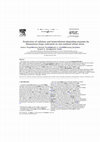
Enzyme and Microbial Technology, 2003
The production of cellulose and hemicellulose-degrading enzymes by cultivation of Aspergillus nig... more The production of cellulose and hemicellulose-degrading enzymes by cultivation of Aspergillus niger ATCC 9029, Botrytis cinerea ATCC 28466, Penicillium brasilianum IBT 20888, Schizophyllum commune ATCC 38548, and Trichoderma reesei Rut-C30 was studied. Wet-oxidised wheat straw suspension supplemented with NH 4 NO 3 , MgSO 4 , and KH 2 PO 4 was used as cultivation medium aiming to obtain an enzyme mixture optimal for enzymatic hydrolysis of wet-oxidised wheat straw. The cultivations with B. cinerea and P. brasilianum gave the highest endoglucanase (EC 3.2.1.4) and -glucosidase (EC 3.2.1.21) activities, in contrast to the other fungi where lower activities were found. The culture filtrates were concentrated by ammonium sulphate precipitation. After enzyme concentration, the highest enzyme activities (1.34 FPU/ml) were found in the culture broth originating from P. brasilianum. Enzymatic hydrolysis of filter cake from wet-oxidised wheat straw for 48 h with an enzyme loading of 5 FPU/g biomass resulted in glucose yields from cellulose of 58% (w/w) and 39% (w/w) using enzymes produced by P. brasilianum and a commercial enzyme mixture, respectively. At higher enzyme loading (25 FPU/g biomass) using either enzyme mixtures the glucose yield from cellulose was in the range of 77-79% (w/w).
Composites Science and Technology, 2007
... and the porosity is low, and (ii) at the region of high fibre weight fractions, the fibre vol... more ... and the porosity is low, and (ii) at the region of high fibre weight fractions, the fibre volume fraction tends to be constant, and ... Composite volumetric interaction has been studied by Madsen [3],Thygesen [4], Andersen and Lilholt [7], and Madsen and Lilholt [8]. Subsequent work ...

Cellulose, 2005
A comparative study of cellulose crystallinity based on the sample crystallinity and the cellulos... more A comparative study of cellulose crystallinity based on the sample crystallinity and the cellulose content in plant fibres was performed for samples of different origin. Strong acid hydrolysis was found superior to agricultural fibre analysis and comprehensive plant fibre analysis for a consistent determination of the cellulose content. Crystallinity determinations were based on X-ray powder diffraction methods using sideloaded samples in reflection (Bragg-Brentano) mode. Rietveld refinements based on the recently published crystal structure of cellulose Ib followed by integration of the crystalline and amorphous (background) parts were performed. This was shown to be straightforward to use and in many ways advantageous to traditional crystallinity determinations using the Segal or the Ruland -Vonk methods. The determined cellulose crystallinities were 90 -100 g/100 g cellulose in plant-based fibres and 60 -70 g/100 g cellulose in wood based fibres. These findings are significant in relation to strong fibre composites and bio-ethanol production.
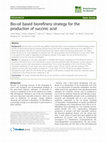
Biotechnology for Biofuels, 2013
Background: Succinic acid is one of the key platform chemicals which can be produced via biotechn... more Background: Succinic acid is one of the key platform chemicals which can be produced via biotechnology process instead of petrochemical process. Biomass derived bio-oil have been investigated intensively as an alternative of diesel and gasoline fuels. Bio-oil could be fractionized into organic phase and aqueous phase parts. The organic phase bio-oil can be easily upgraded to transport fuel. The aqueous phase bio-oil (AP-bio-oil) is of low value. There is no report for its usage or upgrading via biological methods. In this paper, the use of AP-bio-oil for the production of succinic acid was investigated. Results: The transgenic E. coli strain could grow in modified M9 medium containing 20 v/v% AP-bio-oil with an increase in OD from 0.25 to 1.09. And 0.38 g/L succinic acid was produced. With the presence of 4 g/L glucose in the medium, succinic acid concentration increased from 1.4 to 2.4 g/L by addition of 20 v/v% AP-bio-oil. When enzymatic hydrolysate of corn stover was used as carbon source, 10.3 g/L succinic acid was produced. The obtained succinic acid concentration increased to 11.5 g/L when 12.5 v/v% AP-bio-oil was added. However, it decreased to 8 g/L when 50 v/v% AP-bio-oil was added. GC-MS analysis revealed that some low molecular carbon compounds in the AP-bio-oil were utilized by E. coli.
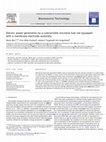
Bioresource Technology, 2012
Membrane electrode assemblies (MEAs) were incorporated into the cathode chamber of a submersible ... more Membrane electrode assemblies (MEAs) were incorporated into the cathode chamber of a submersible microbial fuel cell (SMFC). A close contact of the electrodes could produce high power output from SMFC in which anode and cathode electrodes were connected in parallel. In polarization test, the maximum power density was 631 mW/m(2) at current density of 1772 mA/m(2) at 82 Ω. With 180-Ω external resistance, one set of the electrodes on the same side could generate more power density of 832±4 mW/m(2) with current generation of 1923±4 mA/m(2). The anode, inclusive a biofilm behaved ohmic, whereas a Tafel type behavior was observed for the oxygen reduction. The various impedance contributions from electrodes, electrolyte and membrane were analyzed and identified by electrochemical impedance spectroscopy. Air flow rate to the cathode chamber affected microbial voltage generation, and higher power generation was obtained at relatively low air flow less than 2 mL/min.
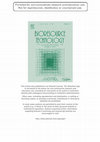
Bioresource Technology, 2008
A pilot plant (IBUS) consisting of three reactors was used for hydrothermal treatment of wheat st... more A pilot plant (IBUS) consisting of three reactors was used for hydrothermal treatment of wheat straw (120-150 kg/h) aiming at coproduction of bioethanol (from sugars) and electricity (from lignin). The first reactor step was pre-soaking at 80°C, the second extraction of hemicellulose at 170-180°C and the third improvement of the enzymatic cellulose convertibility at 195°C. Water added to the third reactor passed countercurrent to straw. The highest water addition (600 kg/h) gave the highest hemicellulose recovery (83%). With no water addition xylose degradation occurred resulting in low hemicellulose recovery (33%) but also in high glucose yield in the enzymatic hydrolysis (72 g/100 g glucose in straw). Under these conditions most of the lignin was retained in the fibre fraction, which resulted in a lignin rich residue with high combustion energy (up to 31 MJ/kg) after enzymatic hydrolysis of cellulose and hemicellulose.
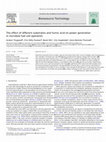
Bioresource Technology, 2009
Electricity production from acetate, glucose and xylose with humic acid as mediator was investiga... more Electricity production from acetate, glucose and xylose with humic acid as mediator was investigated in two chambers microbial fuel cells (MFCs). Acetate produced the highest voltage (570 mV with 1000 Omega) and maximum power density (P(maxd)=123 mW/m(2)) due to a simpler metabolism than with glucose and xylose. Glucose and xylose resulted in P(maxd) of 28 mW/m(2) and 32 mW/m(2) at lower voltage of 380 mV and 414 mV, respectively. P(maxd) increased by 84% and 30%, for glucose and xylose respectively, when humic acid (2g/l) was present in the medium. No significant effect was found with acetate since the internal resistance possessed a limiting effect. The increase of P(maxd) due to humic acid presence was attributed to its ability to act as mediator. Even though pH decreased to 5 with glucose and xylose, due to production of acetate and propionate, the voltage remained on the same level of 250-350 mV.
Biomass and Bioenergy, 2011
Electricity production from microbial fuel cells fueled with hydrolysate produced by hydrothermal... more Electricity production from microbial fuel cells fueled with hydrolysate produced by hydrothermal treatment of wheat straw can achieve both energy production and domestic wastewater purification. The hydrolysate contained mainly xylan, carboxylic acids, and ...

Biochemistry, 2005
The metabolic pathway for histidine biosynthesis is interesting from an evolutionary perspective ... more The metabolic pathway for histidine biosynthesis is interesting from an evolutionary perspective because of the diversity of gene organizations and protein structures involved. Hydrolysis of phosphoribosyl-AMP, the third step in the histidine biosynthetic pathway, is carried out by PR-AMP cyclohydrolase, the product of the hisI gene. The three-dimensional structure of PR-AMP cyclohydrolase from Methanobacterium thermoautotrophicum was solved and refined to 1.7 A resolution. The enzyme is a homodimer. The position of the Zn(2+)-binding site that is essential for catalysis was inferred from the positions of bound Cd(2+) ions, which were part of the crystallization medium. These metal binding sites include three cysteine ligands, two from one monomer and the third from the second monomer. The enzyme remains active when Cd(2+) is substituted for Zn(2+). The likely binding site for Mg(2+), also necessary for activity in a homologous cyclohydrolase, was also inferred from Cd(2+) positions and is comprised of aspartic acid side chains. The putative substrate-binding cleft is formed at the interface between the two monomers of the dimer. This fact, combined with the localization of the Zn(2+)-binding site, indicates that the enzyme is an obligate dimer.










Uploads
Papers by Anders Thygesen